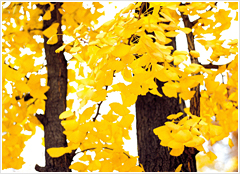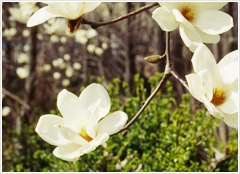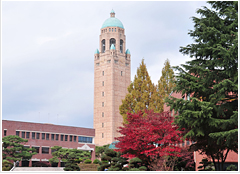-
School Flag

Daejeon Institute of Science and Technology Flag
The symbol mark embodies the founding principles of the institute, including worshiping God, serving the country, and loving one's neighbors, revolving around the cross, which represents the Christianity of the school. The symbol mark ensures the unity of the visual image, delivering the consistent image of the institute and creates a sense of unity among the students and the faculty. -
School Tree

Ginkgo Biloba Linn
Scientific name: Ginkgo Biloba Linnaeus English name: Ginkgo Tree, Maidenhair Tree Native to China, Ginkgo trees reach a height of 60m. It is known to grow naturally in Zhejiang province in China and easily found around temples, entrances to villages, streets and parks in Korea. Ginkgo trees are large, beautiful trees and known to be long-lived. They rarely suffer disease or insect problems and 'provide wide and thick shade, they are often planted to serve as arbors or roadside trees. As they have the smooth, even, and dense texture of ginkgo wood, they are used to build furniture, sculptures, Go-game plates, and dining tables. Koreans believed that the shape of Ginkgo leaves could tell whether the harvest of the year would be successful or not, the crying sound of Ginkgo trees meant disasters would occur, and they would bleed red blood if wielding an ax against them. -
School Flower

Magnolia Kobus
Scientific name: Magnolia kobus English name: Kobus Magnolia, Thunbers Magnolia Native to China, it is a deciduous broadleaf tree and widely planted for decorative purposes. It can reach 15-20 meters in height and 30 m in diameter. In Korea, Kobus Manolia is a popular decorative tree nationwide and also found around temples. The flower buds of Magnolia Kobus always face the North, symbolizing the consistent fidelity to the king. It is also called Bukhyanghwa (North facing flower) as retainers greet to the king who sits on the North side of room. The flower buds resemble the shape of paint brush. Individual flower is also called a gem stone while a group of Kobus Manolia is called a gem tree or pieces of fragrance as each piece of the flower carries fragrance. It is sometimes described as a gem mountain or ‘calling spring with snow.’ Other names include Mokran (Magnolia) and Okran (gem orchid). -
Hyechon Tower

Daejeon Institute of Science and Technology's Landmark Building, Hyechon Tower and Carillon
Hyechon Tower is located in the center of Nokjiwon, a green garden, seen on the right side when entering the campus. It represents the founding principles of Daejeon Institute of Science and Technology of reaching from the ground to sky. The tower is 78m in height and has 13 floors above the ground, 1 floor under the ground, and a rooftop floor. From the second floor to 11th floor, it is in a shape of a square tower with 11 m length of each side. The first floor is a basic floor and the tower is built on the basic floor. Round electronic clocks with a four-meter diameter are also installed on the four sides of the outer wall of the 10th floor. Although this tower can be called as a clock tower, it was originally built to install carillon bells as a bell tower. Hyechon Tower







